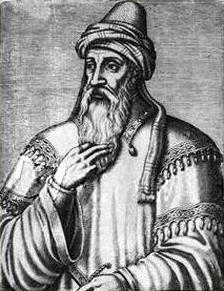Saladin

Saladin - whose real name was Salah al-Din Yusuf - was a celebrated Muslim leader. Saladin was born into a prominent Kurdish family with a father who worked for the Turkish governor ‘Imad ad-Din Zangi ibn Aq Sonqur in northern Syria. As a result, Saladin spent mush of his youth in either Ba’lbek or Damascus, where he favoured the study of religion.
Once Saladin was of working age he managed to secure a job working with his uncle Asad ad-Din Shirkuh, who was an important military commander under Nur al-Dun, sone and heir of Zengi. Following the death of Zengi, three military expeditions into Egypt began, all led by Shirkuh, in an attempt to prevent the country from falling to the Frankish (Latin Christian) rulers of the Kingdom of Jerusalem. As a result, Amalric I (king of Jerusalem), Shirkuh and Shawar (leader of the Egyptian Fatimid caliph, began a three-way struggle for control.
Aged 31, Saladin took part in the third expedition and began his approach to Cairo on 2 January 1169. The Franks retreated as he approached, allowing him to enter, and he ordered the assassination of Shawar on 18 January. Shirkuh was made leader but his reign was short - on 23 March he died suddenly and Saladin was appointed the commander of the Syrian troops in Egypt and leader of the Fatimid caliph in 1169.
Saladin was now known as the Sultan and became the Sole Master of Cairo, as well as the first Ayyubid Sultan of Egypt, in 1174. Historians have often celebrated Saladin as a chivalrous historical figure who was fair in battle - while the pilgrims of the First Crusade carried out mass murder when they took Jerusalem in 1099, Saladin re-took the Holy City in 1187 (following the defeat of the King of Jerusalem at the Battle of Hattin) he allowed all of its inhabitants to leave safely.
Saladin called this a ‘just war’, stating that his actions were out of respect for the city’s status. Additionally, despite fiercely opposing Christian powers, he had a respectful relationship with King Richard I of England (Richard the Lionheart), and even offered Richard his personal doctor when he was wounded in a battle against Saladin.
The Sultan had such success in uniting the Muslim world that he even shocked the Christians of western Europe. However, Pope Gregory VIII still ordered another crusade to regain the Holy City, which marked the start of the Third Crusade. This was led by King Richard I, alongside Emperor Frederick Barbarossa of Germany and King Philip II of France. At the time, these were arguably three of the most important men in western Europe, making the crusade incredibly significant.
The Third Crusade lasted from 1189 to 1192, and it was just one year before it ended when Richard decided to fight Saladin. At the Battle of Arsur in September 1191, Richard defeated the enemy but delayed his attack on Jerusalem in order to rest his army. Instead, he marched on the city in June 1192.
By the time he arrived in the Holy City, Richard was suffering himself, displaying a fever and desperate for food. He requested that Saladin send fresh fruit and water and the Muslim leader obliged, sending the fruit as ordered and frozen snow as water.
According to historians there are two reasons why Saladin may have given in tot he requests of his enemy. The first is that Saladin was a strict Muslim, which meant he strongly believed in helping those in need. Secondly, the delivery allowed his men to enter Richard’s camp and spy on the enemy to asses their soldiers and equipment. It was during these visits that Saladin concluded that Richard had a small force, and decided they would be unable to defeat him and take Jerusalem.
Saladin and Richard organised a truce - pilgrims from Europe would be allowed to visit the city without being troubled by the Muslims and Richard would end his mission to retake the city. Neither leader was particularly happy with this decision, but both sides signed the agreement in October 1192. Once he had done so, Richard returned home, never to return to Jerusalem again.
Saladin’s approach to the crusade has been celebrated; not only did he protect its territory, but he also protected its ideology and returned it to a well-protected but enjoyable city, which allowed commercial and cultural freedom. The leader also made good use of Cairo - using it to accumulate the money he needed to fight against the crusaders.
The Citadel
Despite his success in the Third Crusade, Saladin is perhaps best known for the creation of the Cairo military fortress, the Citadel. The was built between 1176 and 1177, alongside the construction of the college-mosque, the madrassa, where religion and Islamic law was taught to residents. Saladin also ordered the construction of a wall that enclosed the whole city, from Badr’s wall in the North to the Nile in the west and on to the port of al Maks in the east. Although little of these walls remains today, the original perimeter of the Citadel still stands.
Saladin sold the Fatimids’ treasure in order to pay his Turkish troops, and this went from strength to strength in terms of his military career. Upon leaving Cairo in 1182, Saladin went to Syria to fight the crusaders and liberated much of Palestine from the English and other armies, as well as from the control of the Pope. He died 11 years later in Damascus to be succeeded by his brother al Adil.
See also: Richard the Lionheart and The Third Crusade
MLA Citation/Reference
"Saladin". HistoryLearning.com. 2025. Web.
Key facts
| Name: | Saladin |
| Birth Date: | 1138 |
| Death: | 4 March 1193 |
| Religion: | Sunni Islam |
| Reign: | 1174 - 1193 |
| Known for: | Defeating Crusaders at Battle of Hattin and recapturing Jerusalem |
